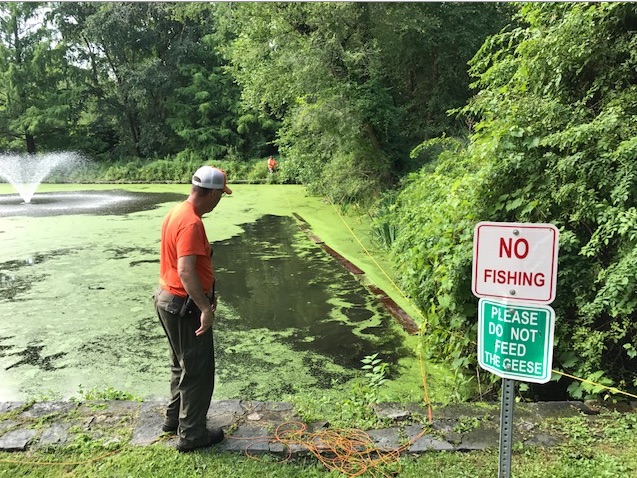Duckweed Covers Pond on Brewster Road
- Category: On Our Radar
- Published: Thursday, 03 August 2017 12:15
- Joanne Wallenstein
Audrey Hochberg Pond on Brewster Road seems to have a case of duckweed, a phosphorescent green film that is cover the surface of the pond.
This morning, August 3, we found a team from the Scarsdale Department of Public Works using pulleys and boards to sweep the weed off of the surface of the pond. It was being collected on the side of the pond for pick-up and disposal.
 According to Benny Salanitro who heads the Department of Public Works, the duckweed is not harmful. It is easier to skim it off the top than to use a chemical solution --and the department is removing it just to improve the appearance. He also noted that the department had installed a larger aerator making the pond a lovely spot to relax and meditate.
According to Benny Salanitro who heads the Department of Public Works, the duckweed is not harmful. It is easier to skim it off the top than to use a chemical solution --and the department is removing it just to improve the appearance. He also noted that the department had installed a larger aerator making the pond a lovely spot to relax and meditate.
What exactly is duckweed and is it bad or good?
Here is an explanation from the Edgemont Association newsletter, explaining the presence of the weed on Crane Pond several years ago:
What is duckweed?
Duckweed belongs to the family Lemnaceae and is small, free floating green plants that form large blankets on the surface of sheltered water. The body of duckweed is composed of a simple floating disc of photosynthetic tissue often with roots attached. It is not differentiated into stem and leaf tissue. All species of duckweed supposedly produce minute flowers, but these flowers are seldom observed. Reproduction is generally vegetative and its growth rate is tremendous. A thumb-sized planting will cover 1.2 acres in 55 days if uninhibited.
Duckweed has some desirable properties for water purification:
Duckweed treats waste by breaking it down and converting it into two components: biomass (duckweed leaves and roots) and treated water. Using duckweed for water purification is definitely low tech and needs a lot of space to be effective. Also, duckweed cannot process heavy metals, pesticides, or toxic substances.
Duckweed blooms typically occur in shallow waters rich in nutrients, especially phosphorus and/or nitrogen. Many studies have indicated that duckweed growth is a function of nutrient levels and not pH and/or temperature. If duckweed becomes an operational problem (i.e. clogging outlets), destroying the duckweed layer with herbicides does not solve the problem of excessive nutrients in the water. In addition, the chemical herbicides may be toxic to animal life, either directly or through biological magnification.
Because of the exponential growth rate Lemnaceae, herbicides must be used repeatedly (perhaps several times a year). Herbicides should be used with extreme caution and under careful supervision. Biological controls using ducks, fish, turtles, and crustaceans may also help control duckweed populations; however, this type of control is generally not suitable for wastewater systems. The mechanical removal of the duckweed cover can also remove some the nutrients. Stopping the inflow of excessive nutrients and the repetitive removal of the duckweed will greatly reduce the growth of duckweeds. Ideally, the best control is to eliminate the influx of excessive nutrients in the system.
In a nut shell, duckweed is present in water that has high levels of phosphorus and/or ammonia and unless it poses an operational problem it does not need to be removed.
Another way to eliminate the growth of duckweed or algae in a pond is to add supplemental biological products to help degrade any organics in the system. These bacteria will grow and create a stronger biomass and thereby reduce the amount of food or nutrients available for the duckweed or algae and out compete them.













